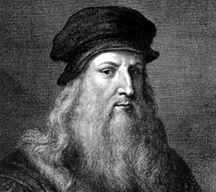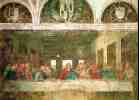The
da Vinci Project


First a Little Biography
Leonardo Davinci has proven
to be one of the most influential men of all time. Many of this
greatest discoveries and inventions are still used today. DaVinci
came from a very modest upbringing. He was the illegitimate son
of notary Piero daVinci and his 17 year old mistress Caterina.
Although his parents were never married he was recognized by his
father and moved with him to Florence when he was about 15. By
the time he was 17 he was an apprentice to a local craftsman by
the name of Verrochio. In 1472 he was admitted to a painters guild.
Even at this time he felt that he was one of the most talented
men in Florence. At this time some of the finest artists in Florence
were comissioned to work on a special project, when daVinci was
not chosen he was outraged and left to become a patron to the
pope and Medici families. By the merit of his work, and his own
bragging of his skills he was comissioned by the Duke of Milian
to work on various military
projects and artworks. There he only completed six works in seventeen
years. The Duke was chased away by French Troops not long after.
DaVinci was working on the Madonna, and the Last Supper at the
time, but he decided to leave when Gascon Bowmen troops of Louis
the XII began to use his works for target practice. He left ouraged
and indirected. He wandered for a few years until he was offered
the position as chief architectural advisor for Isabella d'Este
from 1495-1499. From there he became chief military engineer for
Casare Borgia from 1502-1503. He returned to Florence in 1503
until 1506. He was commissioned to paint a huge fresco of the
Battle of Anghiari, on a wall that just happened to face a painting
by his young rival Michalangelo. It was during this period of
time that he produced his most famous painting, the Mona Lisa.
When he was finished be returned to Milan to finish some of the
other projects that he had left unfinished. There he settled in
his Father's estate where he worked on many of his engineering
and science projects. He was later invited to live in a castle
in Amboise where he died in May 2, 1519. He was buried in a cloister
of San Florentino in Amboise.
Leo's Machines and Manuscripts
Machines
Living in the age of new found
awe in learning, Leonardo immersed
himself in the culture. Residing in Florence allowed him the
opportunity to
bear witness to many important advancements and made him think
about
some of his very own. His included war, flying, work, water and
land machines. Mr. Bacig discussed his armored car in class a
couple of weeks ago. As many people know the Germans were famous
for their invention of the machine gun during WWI, but few know
that the idea was stumbled upon by Da Vinci a long time before
then. Take a look at the picture on of how
his "machine gun" looked like. He called it a 33-barreled
organ. It included
33 small guns, with 3 rows of eleven guns stacked up on top of
each other. The organ was mounted on a single revolving framework.
One a person shoots off the first row of ammunition, then he may
set up the second and third rows right after one another. The
muzzle-loading guns are held together by hinge to the framework
so it is able to swing up for loading. When loaded, the barrels
are kept in place by a metal bar with wooden pins.
Another one of his inventions is the drilling machine. Possibly
used
to clear out an area to put in supports, the drill was very advanced
for its time. It made deep drilling and digging easy. At first
the drill is
thrust into the ground by rotating the upper bar, while, rotating
the second
bar, the drill is then moved back up without turning and when
it is lifted out
of the ground all the earth is collected on it.
Manuscripts
Leonardo wrote in Italian using
a special kind of shorthand that he invented himself. People who
study his notebooks have long been puzzled by something else,
however. He usually used "mirror writing", starting
at the right side of the page and moving to the left. Only when
he was writing something intended for other people did he write
in the normal direction. People who were contemporaries of Leonardo
left records that they saw him write and paint left handed. He
also made sketches showing his own left hand at work. Being a
lefty was highly unusual in Leonardo's time. Because people were
superstitious, children who naturally started using their left
hands to write and draw were forced to use their right hands.No
one knows the true reason Leonardo used mirror writing, though
several possibilities have been suggested:
He was trying to make it harder
for people to read his notes and steal his ideas.
He was hiding his scientific
ideas from the powerful Roman Catholic Church, whose teachings
sometimes disagreed with what Leonardo observed.
Writing left handed from left
to right was messy because the ink just put down would smear as
his hand moved across it. Leonardo chose to write in reverse because
it prevented smudging.
After Leo died in 1519, Francesco
Melissa (da Vinci's favorite student) carried a lot of his manuscripts
and drawings back to Italy. His manuscripts included 5,000 pages
of drawings, and notes. This is the largest collection from the
entire renaissance and endured many trials even after his death.
Due to mishandling, his manuscripts are nothing like they were
back then when they
were grouped together by the master. Melzi's heirs, after his
death in
1579, began to lazily scatter his works. They originally stored
them in a
loft but then sold separate sheets cheaply to friends and collectors.
One of
these people was Barnabite Antonio Mazenta, a sculptor, who decided
to
rearrange his collection and split the artistic drawings from
the technical ones. He split up the original texts, cut and pasted
papers together and created two separate books. "Codex Atlanticus"
and the Windsor collection which is 600 pages long. He also created
four more volumes in this rude manner. After Mazenta's death,
the texts were brought back to Italy, where they were eventually
ended up in the hands of Napoleon Bonaparte in 1796. Through out
the whole transformation of the works, manuscripts were lost,
destroyed and separated. Upon chance they were rediscovered in
the National Library of Madrid in 1966. The"Vinci Royal Commission"
was set up in order to redo the original arrangement of the manuscripts.
"There has never been an
artist who was more fittingly, and without
qualification, described as a genius."
Leonardo Da Vinci:
Scientist, Inventor, Artist.
In 1496 Leonardo Da Vinci's
father apprenticed him into Verocchio's
workshop. This is where got his start in the art world. Verocchio
emphasized perspective to Da Vinci. The emphasis on perspective
(which
is still difficult for modern day artists) shows up later in Leonardo's
studies and art work. All of his paintings have a focal point
hidden in
the back of the painting that help to make Da Vinci's paintings
even
more realistic. He also spends many hours sketching faces and
cloth to
try to perfect the art of drawing such difficult and always changing
shapes. By his early twenties, Da Vinci was famous and had surpassed
his
master.
The time was Renaissance Italy, and there were no photographs,
but
Leonardo took painting very seriously. People today call his paintings
a "universal language." The paintings clearly emphasize
how important
art can be. And his paintings are of such an excellent quality
that
they are compared to those of photographs. The paintings he made
of the
human skeleton were so exact that they are still used today in
some
medical classes. Leonardo used perspective and his realistic elements
(like the cloth studies) to make his painting s come to life.
He
painted what he saw. Leading the painting world in to a revolution
of
objective painters where before they had been dominated by unrealistic
painters.
Leonardo's studies went on to include techniques that dealt with
light
and shadow. He also studied things in nature, and tried to draw
what
ever he saw exactly how he saw it. He began to draw in three
dimensions, which was a fairly new idea, especially when dealing
with
landscapes and bodies. He began to give his paintings life like
quality
and made such amazing paintings as the famous Mona Lisa.
Leonardo was so consumed with his passion to draw exact pictures
that
he turned to science to help him along. As mentioned he made a
study of
light and shadow, cloth, faces, bodies, nature and (most horridly)
the
anatomy. But the result of such diligent studies is the very realistic
paintings that he has left for the world to enjoy. He was a grave
robber, and could have been arrested, but the passion to pursue
the
truth was too great. So he risked such adventures as grave robbing
so
that he could dissect bodies and draw what it was he found. This
study
of the human anatomy and body allowed Leonardo to draw his realistic
paintings. He determined an ideal human figure, but a realistic
human
figure and used them in his paintings.
Leonardo was a genius. He used science to perfect his art. He
knew that
art was more, and he used his laws of perspective and nature to
draw
his wonderful paintings. He believed that "the eye was the
perfect
instrument for learning these laws, and the artist the perfect
person
to illustrate them."
Leonardo's Paintings
Mona Lisa
Leonardo painted the Mona Lisa
in 1506 on a piece of pine wood.
What is the big deal with the Mona Lisa ? Is it her smile? Or
the way
she looks at you? Who is this woman? No one knows exactly who
she is or
if she even existed. Some say that she is smiling because she
was
secretly pregnant. But where did they come up with such an idea?
However, one of the oddest and most intriguing theories is that
the
Mona Lisa is actually a self portrait of the painter... Leonardo
Da Vinci! Some actually believe that he made the painting of himself
as
he would look if he were a woman. X-rays of the painting have
helped to
fuel the rumor and it is an amazing but very possibly the truth.
Da Vinci would be just the man to pull off such a scam to the
public.

The Last Supper
The Last Supper is falling apart. One of Leonardo's best-known
paintings, it is doomed because of Leonardo's experimenting with
perspective and such. It is a mural and it began to deteriorate
even before Leonardo's death. It was
repainted twice in the 18th century after the painting was no
longer
decipherable. The painting suffered worse fates when Napoleon's
soldiers invaded, and when a group of monks thought it would be
good to
place a door at the bottom of the painting. So the painting is
falling
apart, there is a whole in the bottom of the painting and what
would
happen? World War II... thankfully the mural somehow survived
the
massive bombings and that is when things started to pick up for
the
mural. A group of restorers discovered that most of the original
work
remained and restored it to it's original glory... well, pretty
much.
Well da Vinci also did some
fortress building. He designed a few castles. Here go to our da Vinci architecture page.
Hey you want more pics??
Want some links?
Page Built By:
Jeff McCann
Jonny Thompson
Erica Ende
Lindsay Tufte
Meghan O'Brien




